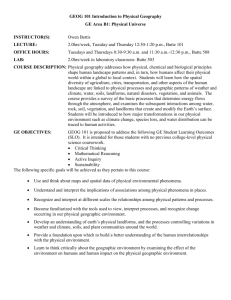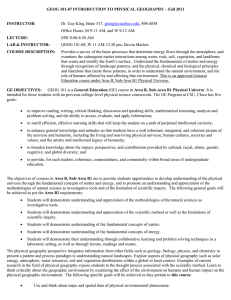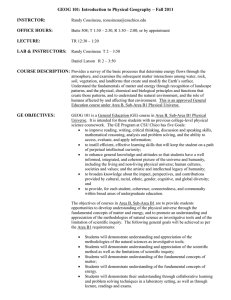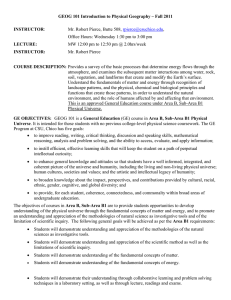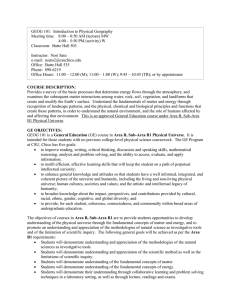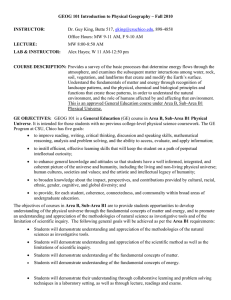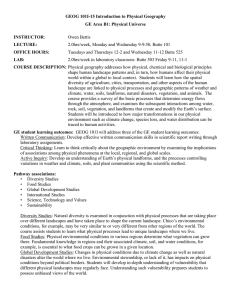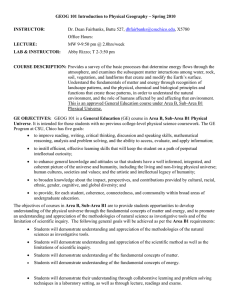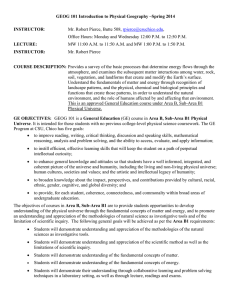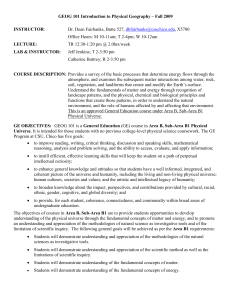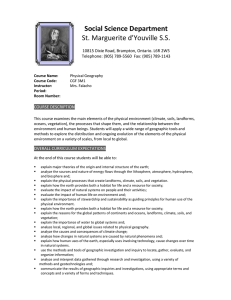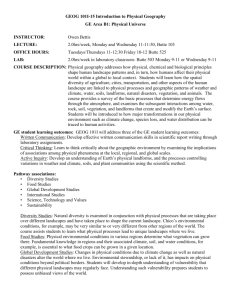GEOG 101-09 Introduction to Physical Geography GE Area B1: Physical Universe INSTRUCTOR LECTURE:
advertisement
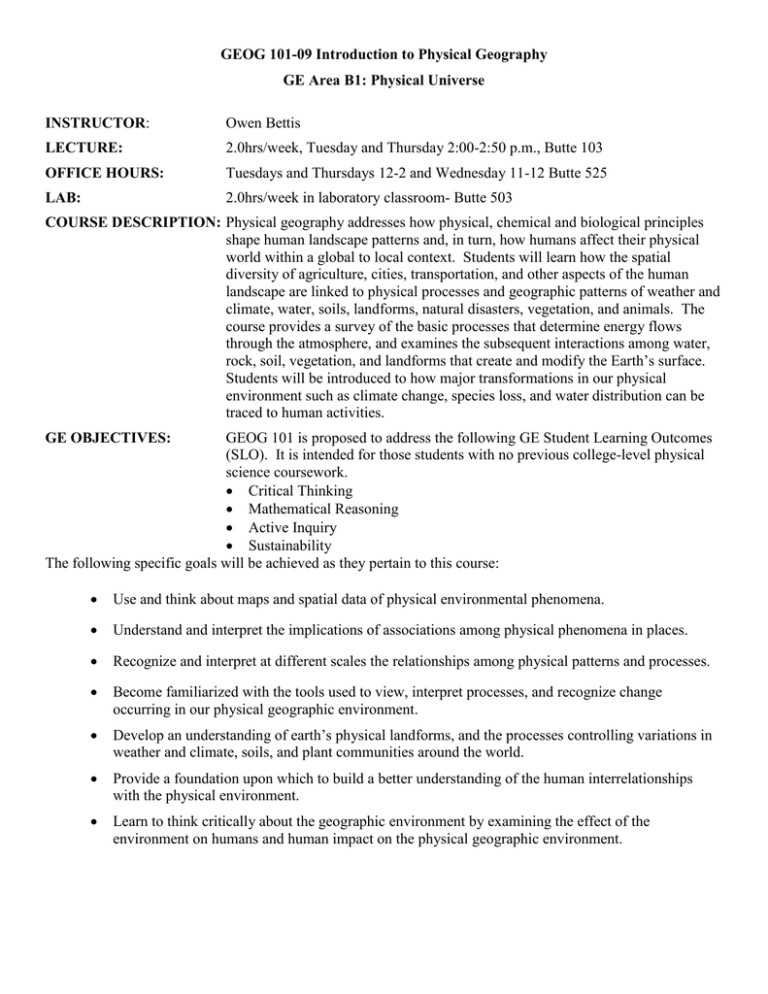
GEOG 101-09 Introduction to Physical Geography GE Area B1: Physical Universe INSTRUCTOR: Owen Bettis LECTURE: 2.0hrs/week, Tuesday and Thursday 2:00-2:50 p.m., Butte 103 OFFICE HOURS: Tuesdays and Thursdays 12-2 and Wednesday 11-12 Butte 525 LAB: 2.0hrs/week in laboratory classroom- Butte 503 COURSE DESCRIPTION: Physical geography addresses how physical, chemical and biological principles shape human landscape patterns and, in turn, how humans affect their physical world within a global to local context. Students will learn how the spatial diversity of agriculture, cities, transportation, and other aspects of the human landscape are linked to physical processes and geographic patterns of weather and climate, water, soils, landforms, natural disasters, vegetation, and animals. The course provides a survey of the basic processes that determine energy flows through the atmosphere, and examines the subsequent interactions among water, rock, soil, vegetation, and landforms that create and modify the Earth’s surface. Students will be introduced to how major transformations in our physical environment such as climate change, species loss, and water distribution can be traced to human activities. GE OBJECTIVES: GEOG 101 is proposed to address the following GE Student Learning Outcomes (SLO). It is intended for those students with no previous college-level physical science coursework. Critical Thinking Mathematical Reasoning Active Inquiry Sustainability The following specific goals will be achieved as they pertain to this course: Use and think about maps and spatial data of physical environmental phenomena. Understand and interpret the implications of associations among physical phenomena in places. Recognize and interpret at different scales the relationships among physical patterns and processes. Become familiarized with the tools used to view, interpret processes, and recognize change occurring in our physical geographic environment. Develop an understanding of earth’s physical landforms, and the processes controlling variations in weather and climate, soils, and plant communities around the world. Provide a foundation upon which to build a better understanding of the human interrelationships with the physical environment. Learn to think critically about the geographic environment by examining the effect of the environment on humans and human impact on the physical geographic environment. ORGANIZATION: The course is based on four parts: Energy-atmosphere system; water, weather, and climate systems; Soils, ecosystems and biomes; and Earth surfaceatmosphere Interface. These parts will introduce students to fundamentals (energy and matter), processes, interactions, scientific analysis methods and spatial patterns within the physical geographic environment, which are associated with the atmosphere, hydrosphere, lithosphere, and biosphere. REQUIREMENTS: Students are responsible for all class materials and should be prepared for lectures by reading the assigned textbook chapters before class and laboratory assignments by reviewing and printing the laboratory manual available via WebCT Vista before laboratory section. CORE TEXT(S): Christopherson (2011). Geosystems. 8th Edition, John Wiley Press, NY. Additional web-based materials available on BlackBoard Learn GRADING POLICIES: Will be determined by scores on the three lecture midterm examinations, the lecture final examination, reading quizzes, laboratory assignments and lab final exam as follows*: First Exam Second Exam Third Exam Final Examination Online Lab Quizzes (10) Lab assignments Applied Analysis Paper 60 points 60 points 80 points 100 points 100 points 100 points 100 points Total 600 points * Point system is subject to change Laboratory assignments: 10% will be deducted each day the final lab report is late up to two days; no credit will be given for tardiness longer than two days, unless a doctor approved illness is noted. Attendance policy: Attendance is expected at every class and laboratory meeting. There is information presented in lecture and laboratory that is not necessarily covered directly in the text. I understand, however, that personal things happen during any semester that may keep you from class. Rather than punish you for not showing up (your grade will most likely drop by itself) I will give you 20 extra credit points if you do not miss a single class or lab. Points will be applied to overall course grade. Course Etiquette: Minor requests: Please, turn off cell phones in lecture and lab to avoid disruption. Please do not eat in lecture or lab (we’re ALL hungry!). Please do not bring drinks in glass bottles into lecture or lab. § Student assignments will be handed back promptly in lab section. Any material not picked up in lecture/lab will be discarded at the end of the semester. Final papers will be held for one semester. Disability Support Services: If you have a documented disability that may require reasonable accommodations, please contact Disability Support Services (DSS) for coordination of your academic accommodations. DSS is located in the Student Services building across from Merriam Library. The DSS phone number is 898-5959 or FAX 898-4411. Visit the DSS website at <http://www.csuchico.edu/dss/>. Statement on Academic Honesty: Academic misconduct (as defined in the current California State University, Chico catalogue, pg 47, 635) will not be tolerated. Students are encouraged to discuss course materials inside and outside the classroom. However, all written lab material submitted by students must be their own work exclusively. No answers to questions cribbed from other students, other classes or the Internet. The highest standards of honesty are expected when taking exams: no sneaking, peeking or cheat sheeting. If you have any questions about what constitutes academic dishonesty, or the consequences of academic misconduct, consult the current university catalogue, the Office of Student Judicial Affairs (Kendall 112), or ask me. Dates Jan Feb Mar Apr May LECTURE SCHEDULE* Lecture topics Text chapters Lab (field trip) 21 23 Physical geography and the scientific method; energy/matter Geographic grid: Latitude, Longitude, Time and Earth motions 1 NO LAB 28 30 Earth-Sun Relationships, Latitudinal effects, Seasons Earth’s Atmosphere 2 3 1 4 6 Energy balance and energy budgets, solar radiation principles Planetary and local temperature patterns 4 5 2 11 13 First Examination Atmospheric and Oceanic Circulation 6 18 20 Wind systems, ocean currents Heat properties of H2O, Humidity, adiabatic processes, clouds/fog 7 25 27 What is weather? Air masses & fronts, lifting mechanisms, storm systems Global Climate Systems, Climate Change, Chasing Ice 8 10 4 6 Climate Change – Chasing Ice Hydrological cycle, California water resources 9 11 13 Second Examination Internal earth energy – radioactive decay, earth materials, rock cycle 11 7 25 27 SPRING BREAK Soils development and classification Tectonic processes in the Earth’s crust, earthquakes, volcanoes 18 12 8 1 3 Weathering processes, mass transport mechanisms Fluvial processes, watersheds 13 14 NO LAB 8 10 Stream erosion, flooding The biosphere: ecosystem processes and patterns 19 15 17 Ecosystems, Habitat, Succession, climate change Third Examination 20 10 (BCCER) 22 24 Biomes, organism distribution and patterns: Biogeography Arid land processes: wind action 15 PAPER 29 1 Arid land processes: wind action Ocean processes: wind and wave 16 PAPER 6 8 Ocean processes: coastal landscapes Human and Environment Interaction; REVIEW 21 PAPER 12-16 3 4 5 6 9 Final Examination, TBA * Schedule is subject to change by instructor. Reasonable efforts to notify students will be made.* PAPER DUE
